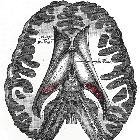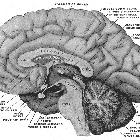ventricular system




The ventricular system in the brain is composed of cerebrospinal fluid (CSF)-filled ventricles and their connecting foramina. CSF is produced by ependymal cells which line the ventricles. They are continuous with the central canal. Ventricles contain around 20% of the total average adult CSF volume, around 20-25 mL.
The ventricular system consists of:
- two lateral ventricles
- a midline third ventricle
- a fourth ventricle
The interconnections between the ventricles occur through the following:
- interventricular foramen (of Monro): lateral to third
- cerebral aqueduct (of Sylvius): third to fourth
- median aperture (of Magendie): fourth to cisterna magna
- two lateral apertures (of Luschka): fourth to cerebellopontine cistern
Both the cisterna magna and the cerebellopontine cistern are in the subarachnoid space. This space is continuous with the subarachnoid space around the cord down to the level of the cauda equina.
Major CSF production comes from choroid plexus found in the lateral, third and fourth ventricles of the brain which are highly vascularized epithelial tissue masses . Notably, choroid plexus is not found in the frontal or occipital horns of lateral ventricles, nor in the cerebral aqueduct.
Development
Embryologically, ventricles originate from the central lumen of the neural tube and the cerebral vesicles to which it gives rise.
Siehe auch:
- Cisterna magna
- Cisterna quadrigeminalis
- dritter Ventrikel
- cerebral aqueduct (of Sylvius)
- Seitenventrikel
- vierter Ventrikel
- Foramina Luschkae
- Foramen Magendii
- subarachnoidale Zisternen
- Entwicklungsstörungen des Ventrikelsystems
- Foramen interventriculare Monroi
und weiter:
- asymmetrische Seitenventrikel
- Cisterna cerebellomedullaris
- Hydrocephalus
- Cella media
- Ventrikulitis
- obex
- transependymales Ödem
- aqueduct of Sylvius
- paediatric intraventricular haemorrhage
- Entwicklungsstörung Seitenventrikel
- intraventrikulär
- Hinterhorn Seitenventrikel
- Liquorfluss
- Anatomie der Liquorräume
- Entwicklung Ventrikelsystem
- Fastigium des 4. Ventrikels
- neurochirurgische Zugänge zum Ventrikelsystem

 Assoziationen und Differentialdiagnosen zu Hirnventrikel:
Assoziationen und Differentialdiagnosen zu Hirnventrikel:








